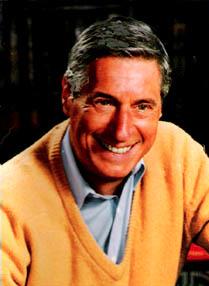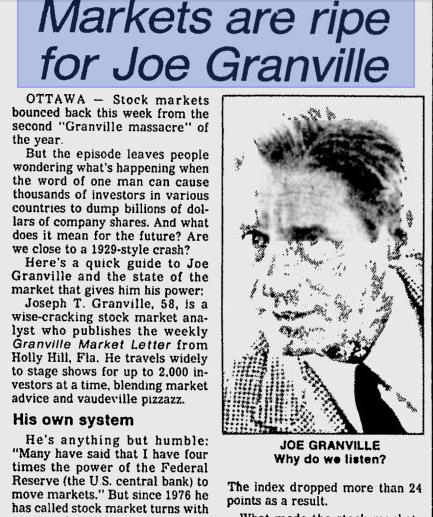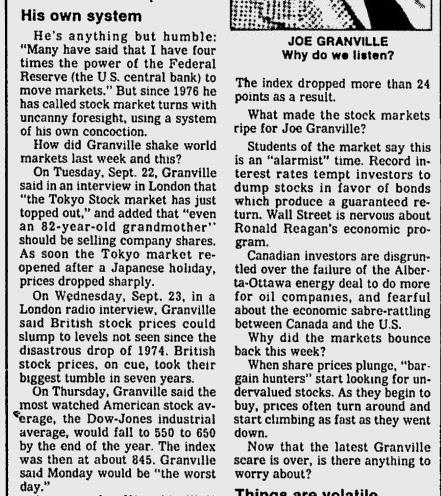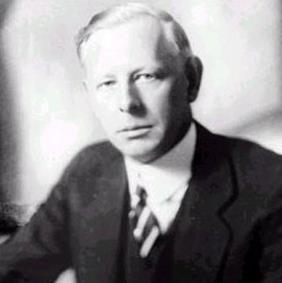Because so many of my “investment” friends hold Warren Buffett in extremely high esteem, I spent some time last week contemplating the financial world’s reaction when the day comes (as, eventually, it certainly will) of his death. We will then become bombarded by a plethora of: media tributes, Twitter and Facebook messages, TV specials and documentaries[1], and countless news and sound bites emanating from Omaha, Nebraska. In addition, there are certain to be at least a few biographies (authorized or not) of Buffett’s life and career, and I can guarantee that photos of Mr. Buffett shaking hands with (or standing next to) one or more persons will inundate social media platforms.
 So imagine my surprise this week when I caught a brief reference to a man about whom I had almost totally forgotten – Joseph E. Granville. Mr. Granville died in Kansas City, Missouri on September 7th at 90 years old![2]
So imagine my surprise this week when I caught a brief reference to a man about whom I had almost totally forgotten – Joseph E. Granville. Mr. Granville died in Kansas City, Missouri on September 7th at 90 years old![2]
As soon as I saw his name, countless mental images began rushing to the fore from the old “Wall Street Week with Louis Rukeyser” television show[3] and all the “direct mail” ads I used to receive promoting Granville’s famous newsletter: “The Granville Letter”.
I immediately decided that both you and I could benefit from taking a few moments to review Mr. Granville’s legacy.
OK, now, folks. I saw some of you roll your eyes – especially the ones so young that they have never previously seen or heard of Joseph Granville! You may be having one of those moments my teenagers had (many years ago) when they travelled long distance with me and I filled the car with music by the Beatles, Rolling Stones, Blind Faith, Yes, Santana, Simon & Garfunkle, and Dan Fogelberg. I was hounded from the back seat by shouts of: “We hate dead people music!”[4]
In his day, Joseph Granville was (putting it mildly) bigger than life! Take a look at these excerpts straight from the front page of The Montreal Gazette on September 30, 1981:[5]
 “Stock markets bounced back this week from the second “Granville massacre” of the year.”
“Stock markets bounced back this week from the second “Granville massacre” of the year.”
Think about that, folks. Granville moved the markets, not once, but twice during 1991!
The story continues: “leaves people wondering what’s happening when the word of one man can cause thousands of investors in various countries to dump billions of dollars of company shares… Are we close to a 1929-style crash?”
Mr. Granville, for better or worse, was not modest. He pointed out that many folks ascribed to him “four times the power of the Federal Reserve”. That was a real overreach. However, we can’t deny that lots of folks acted on his advice:
1) On 9/22/81, he declared that the Toyko exchange had “topped out”… adding “’Even an 82-year old grandmother’ should be selling. Upon the opening of Toyko’s next trading day, the market dropped sharply.
 2) The next day, he warned (on London radio, no less) that British shares could fall to levels not seen for the prior seven years. Sure enough, the next day, the biggest price drop in seven years took place!
2) The next day, he warned (on London radio, no less) that British shares could fall to levels not seen for the prior seven years. Sure enough, the next day, the biggest price drop in seven years took place!
We have recently seen the direct impact on stock prices of attention-getting tweets (false rumors about an attack on the White House … or Carl Icahn describing his long chat with Tim Cook) and Bernanke’s world-shaking reference[6] to “tapering” in late May. However, how many recent stock market tailspins have been catalyzed by interview comments by one single newsletter writer?
What made Granville tick? No one can offer a comprehensive analysis. But one formative influence is undeniable! In his 1984 autobiography, The Book of Granville, he recounted that his father, W. Irving Granville, lost as much as $100,000 of his own money (and funds borrowed from family) during the 1929 stock market crash. According to Granville: “The family survived only because our relatives were comfortable enough to write off their losses and aid us in recovering.… It was my father’s devastating experience with the stock market that made me so sensitive to the economic realities that lay behind every human pursuit.”
After a tour of duty in World War II and graduation from Duke University, Granville was hired by E.F. Hutton & Co. to write its daily stock market letter. Talk about a great way to start an independent career—have a widely followed brokerage company pay you to develop all the skills needed to create, edit, and publish a letter, and provide you with a huge “audience”! Mr. Granville was at least half way toward his life’s success.
What contributions did Granville make to the investment world, besides occasionally scaring the bejeebers[7] out of countless investors around the globe? He was one of the first investment professionals to popularize the use of pure price action as an indicator – versus fundamentals such as earnings, sales, margins, economic data, etc. He also tracked investor sentiment, the number of stocks reaching 52-week highs or lows, and the daily number of advancing and declining stocks.[8] He became a well-respected technical analyst.
In fact, can you guess which highly visible and widely used stock indicator Granville developed?[9] It is “On Balance Volume” (OBV). The way OBV is calculated is almost wickedly simple: 1) If a stock rises, that day’s volume is added to the cumulative OBV; 2) If the price falls, that volume total will be subtracted!
What makes this particular story even more fascinating is the location within which inspiration struck Granville. From Granville’s own writing, here is the story: “[it] caught me, quite literally, with my pants down. One August morning in 1961 I sat on the toilet in the men’s room, away from the hubbub of the research department, musing about the stock market.”[10]
Granville wrote 19 books, including a 1976 book[11] within which he predicted that a bear market would occur in 1977-1978. Keep in mind that he wrote this book in the midst of what turned out to be a two-year rally! How did his prediction fare? Between the beginning of 1977 and February of 1978, the Dow Jones Industrial Index fell by 26%.
Granville’s most infamous moment came in January of 1981, when he told his subscribers to “Sell Everything!” The next day, the market fell by 2.4%! His face graced the front page of the New York Times the next day![12]
One of Granville’s “Old School” colleagues, Robert Stovall[13] offered this on-target eulogy of Granville: “Joe was extremely powerful a generation ago. If he gave the thumbs down to a market, it was like the emperor in the coliseum. The market would go down.”
My recollection of Granville could be simplistically expressed in these words: “A very affable ‘perma-bear’.” That certainly reflects the outsized impact that his father’s experience had on Granville’s investment approach.
Unfortunately, it also accounts for why Granville’s track record (as recorded by the authoritative keeper of such records: The Hulbert Digest) over a 25-year period stood at the very bottom of the rankings! His recommendations produced an average annualized loss of more than 20% during that period!
Isn’t that fascinating! One individual, at least for a time, held such strong influence over an extremely broad group of people that he could (literally) move markets back then in ways that only Ben Bernanke can in today’s markets! And yet, over time, his record proved to be quite lackluster!
Can that teach us anything? You bet it can! The depth and breadth of a human life is much greater than anything we can summarize in a headline. Rather, it is the total summation of all that life’s component parts!
What can Joseph Granville’s life teach us today?
1) How to be better investors: as we use technical analysis (including OBV) we can improve our trading, at least in part, due to advances he helped achieve;
2) His focus on risk can serve to keep us cautious and stay disciplined with our risk-management;
3) His trading rules and principles can be helpful, regardless of his total record; [14]
 Photo: Lest anyone assume that profit and loss are all that is important in valuing a trader’s life, consider the story of Jesse Livermore (left) that I include in the footnote attached.
Photo: Lest anyone assume that profit and loss are all that is important in valuing a trader’s life, consider the story of Jesse Livermore (left) that I include in the footnote attached.
4) Versatility, flexibility, and thinking “outside the box” are good things:
a. He took his investment principles to the pulpit of the Crystal Cathedral in order to widen his audience;
b. He spoke to a standing room audience at Carnegie Hall – teaching with engaging and attention-grabbing humor and homespun stories.[15]
c. At one investment conference, he emerged from a coffin for his entrance;
d. He actually headlined once at Caesar’s Palace in Las Vegas![16]
e. At a conference in Tucson, Granville began his presentation by walking across a swimming pool on an invisible plant just below the surface! How can you not like a guy like that?[17]
5) You are never too old: as he headed toward his 77th birthday, he warned folks that Internet stocks were far too pricey and would soon head for a fall! (That was in 2000.)
6) No matter how successful you become, never stop being gracious and affable!
a. Mark Hulbert tells this story of his appearance on a special “Wall Street Week” show. He appeared on that episode for the purpose of leading the audience through a review of investment newsletter performance.
b. Al Frank, editor of The Prudent Speculator, was present as the representative of outstanding performance!
c. Joseph Granville was there as the example of “awful” performance.
d. Do you grasp the awkwardness in this episode? I would have hated to have been Mr. Granville (or Mr.Hulbert, for that matter!).
e. Here is Hulbert’s remarkable summary: “Granville, videogenic as ever, was beaming, while Frank came across more as a fumbling professor. I wouldn’t be surprised if Granville secured more new subscribers from the show than did Frank.”
7) Finally, as one thinks about those dimensions of life that are of ultimate and lasting value, being thoughtful and kind ranks toward the top.
a. By all accounts, this internationally successful and well-known man was beloved within the little Kansas City community in which he lived with his wife.
b. In the words of one eulogy: “they have become an institution as great and loving neighbors, always at the ready to babysit pets or hand deliver flowers to celebrate life events.
INVESTOR TAKEAWAY: I suggest you re-read the bullet points above regarding “what can Granville teach us”? It is a great example that he leaves us.
Secondly, it might be a good time to review the details of the OBV indicator, and consider new ways it might become more useful to you.
DISCLOSURE: Nothing in this article is intended as a recommendation to buy or sell anything. Always consult with your financial advisor regarding changes in your portfolio – either subtractions or additions.
Submitted by Thomas Petty MBA CFP
[1] Could there even be a movie? Who do you think would portray Mr. Buffett? (No, it won’t be Ashton Kutcher!)
[2] The photo is from www.GranvilleLetter.com
[3] If you never saw it, here is a 10-minute snippet from the show produced following the October 19, 1987 “Crash” (the worst one day stock drop in history). http://www.youtube.com/watch?v=XFn1G2goDQw. Pay attention to who his guests were that day.
[4] Years later, my youngest son once described Simon and Garfunkle as “a random group”! However, God has provided dad with “revenge” – some of his favorite songs are by Led Zeppelin, Eric Clapton, and Santana.
[5] From: http://news.google.com/newspapers?nid=1946&dat=19810930&id=5YAxAAAAIBAJ&sjid=9KQFAAAAIBAJ&pg=3195,4480843
[6] During his testimony before Congress.
[7] Not an official word, but it is listed in the dictionary as an idiom!!
[8] Those metrics became the basis for his “Net Field Trend Indicator” … which he reported in his newsletter.
[9] My instinct tells me less than 20% of average investors could possibly hope to identify the indicator Joseph developed.
[10] Go ahead, Ron… I dare you not to recall that story the next time you are analyzing a stock online and you refer to OBV!!
[11] Granville’s New Strategy of Daily Stock Market Timing for Maximum Profit
[12] At one point, Granville opined that his photo was the only time in history when an investment newsletter writer appeared on the Times’ front page!
[13] Stovall was one of Rukeyser’s most frequent guests on Wall Street Week. Stovall’s son (Robert Jr.) is currently the chief market strategist for Standard & Poor’s, and looks like a brown haired version of his dad.
[14] Jesse Livermore made and lost an unimaginable (“Buffett-Plus” sized) fortune four times, and ended in bankruptcy. And yet his unique trading rules/philosophy live on (as well as a biography of his life) and continue to be considered timeless classics among investment experts!
[15] My editor will not allow me to include the story he used in Minneapolis to describe how he kept track of stocks while on the road. Even I agree it is very off-color; but it is hilarious and worth looking up if you are so inclined!
[16] Now that is a goal for which some of our young investment professionals can begin to aspire!
[17] Note to budding investment professionals – don’t waste time trying to figure out how to do that! One up and coming CEO has almost mastered the art.
Related Posts
Also on Market Tamer…
Follow Us on Facebook

 Is Palantir a Buy?
Is Palantir a Buy?



